|
|
|
Sort Order |
|
|
|
Items / Page
|
|
|
|
|
|
|
| Srl | Item |
| 1 |
ID:
174427
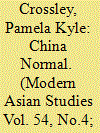

|
|
|
|
|
| Summary/Abstract |
Comparative historians have illuminated the weaknesses in the Europe-derived and Europe-centred historical paradigms of the preceding century-and-a-half, while questioning the factual foundations and depth of Europe's development towards capitalism, imperialism, and industrialism. But a continental perspective on China's early modern development suggests the possibilities of a vicinage—or integrated environment—approach to China's development and its relevance to more widespread changes of the early modern period.
|
|
|
|
|
|
|
|
|
|
|
|
|
|
|
|
| 2 |
ID:
174430
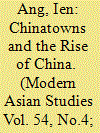

|
|
|
|
|
| Summary/Abstract |
In the early twentieth century, Chinatowns in the West were ghettoes for Chinese immigrants who were marginalized and considered ‘other’ by the dominant society. In Western eyes, these areas were the no-go zones of the Oriental ‘other’. Now, more than a hundred years later, traditional Chinatowns still exist in some cities but their meaning and role has been transformed, while in other cities entirely new Chinatowns have emerged. This article discusses how Chinatowns today are increasingly contested sites where older diasporic understandings of Chineseness are unsettled by newer, neoliberal interpretations, dominated by the pull of China's new-found economic might. In particular, the so-called ‘rise of China’ has spawned a globalization of the idea of ‘Chinatown’ itself, with its actual uptake in urban development projects the world over, or a backlash against it, determined by varying perceptions of China's global ascendancy as an amalgam of threat and opportunity.
|
|
|
|
|
|
|
|
|
|
|
|
|
|
|
|
| 3 |
ID:
174422
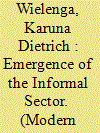

|
|
|
|
|
| Summary/Abstract |
The informal sector and informal employment relations occupy a prominent place in India's economy: one of their key features is the apparent absence of the state from labour regulation. This article seeks to trace the emergence of the division between the formal and informal sectors in India's economy from a historical perspective: it shows how the state, far from being absent, played a fundamental role in creating the dichotomy. This is done through a close study of labour legislation and the politics around it, taking South India as a case study. The article examines the enactment of four laws in Madras province in the late 1940s, ostensibly aimed at protecting workers, and their subsequent implementation by the Madras government. It shows how these laws ended by excluding workers from small unorganized industries (such as beedi-making, arecanut-processing, handloom-weaving, and tanning) from legal protection. It explores the ramifications of this exclusion and argues that the reinforcement of the formal–informal divide was the outcome of a complex political struggle between employers, workers' unions, and the state during this formative period.
|
|
|
|
|
|
|
|
|
|
|
|
|
|
|
|
| 4 |
ID:
174429


|
|
|
|
|
| Summary/Abstract |
This article looks at how globalization in the nineteenth century was inextricably entangled with localization in the Canton–Hong Kong–Macau nexus on the southern fringe of China by tracing the growth of its unique medical culture. It explains the ‘glocalizing’ process by tracing the development of this medical culture, which consists of knowledge construction and institution building, in the context of highly volatile epidemiological conditions aggravated by increasingly heavy inter-regional trade and migration. It traces the dynamic circulation of people, materials, ideas, and practices in this southern edge of China, which was traditionally connected to southeast Asia and shared ecological backdrops that produced similar epidemiological experiences. The Canton nexus in the nineteenth century saw the growth of native medical knowledge that focused less on theoretical innovation than on the efficacy of therapeutic strategies. These ideas were likely to have been informed or reinforced by new anatomical knowledge disseminated by Western medical missionaries on the ground early in the century. The medical culture in the region was also marked by the formation of a series of local institutions that were fusions of Western-style hospitals and native merchant-run charity halls where diseases were studied and treated, and new public health management negotiated and implemented by experts from different traditions.
|
|
|
|
|
|
|
|
|
|
|
|
|
|
|
|
| 5 |
ID:
174424


|
|
|
|
|
| Summary/Abstract |
This article examines the activities of the Syrian hadith scholar Saʿid Muḥammad al-ʿAsali al-Ṭarabulsi al-Shami (1870–1932?), better known as Shami Damulla, as a window onto the relationship between the Ottoman empire and the Muslims of Xinjiang, or Eastern Turkistan. Scholars of Islam in the Soviet Union have identified al-ʿAsali as an influential figure in Soviet Turkistan in the 1920s, but much remains to be clarified about his formative years, and his multiple sojourns in China prior to the Russian Revolution. Here, I seek to fill some of these gaps by tracing al-ʿAsali's connections to modernist and revivalist scholarly circles in India and the Middle East, his activities in Xinjiang, and the strategies he adopted to insert himself into the relationship between the Ottoman court and China. These strategies were both political and intellectual. While moving within Muslim communities across Eurasia, al-ʿAsali also sought to engage the Chinese tradition on its own terms, authoring a 1905 study of Qing institutions entitled The Law of China (Qanun al-Sin)—a rare example of intellectual exchange between late-Ottoman Islamic reformism and the revitalized Confucianism of the late Qing. From a diverse range of sources, a picture emerges of a figure much more complicated, though no less controversial, than can be found in existing characterizations of al-ʿAsali.
|
|
|
|
|
|
|
|
|
|
|
|
|
|
|
|
| 6 |
ID:
174426


|
|
|
|
|
| Summary/Abstract |
‘Global China: New Approaches’ consists of four articles that explore the methodological contours between transnational history and China studies. China historians have not been invulnerable to the excitements of transnational history. Few would be happy to be suspected of still believing in a unique and enduring Chinese essence, and fewer still would be willing to argue that the foreign has been irrelevant in China, not just for the last two centuries but for its entire history. The urge to break free from histories shackled to the nation-state (whether told as revolution or not), the desire to be alert to connections with other areas of the world, and the wish to escape from teleological narratives characterize much of the most arresting work done on China in recent years. China-centredness has not disappeared, but it certainly has attenuated.
|
|
|
|
|
|
|
|
|
|
|
|
|
|
|
|
| 7 |
ID:
174423
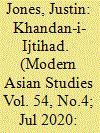

|
|
|
|
|
| Summary/Abstract |
Revisiting the debate on how Islam's ‘learned men’ (‘ulama) have sustained their religious authority through changing historical circumstances, this article offers a longue durée account of the so-called ‘Khandan-i-Ijtihad’: a family of renowned scholars and jurists who have held scholarly and popular precedence within South Asia's Shi‘i clerical networks for some 250 years. Instead of analysing the ‘ulama as a corporate group or a class of religious professionals, this article examines the ‘ulama as members of households (khandan, khanwadah) and emphasizes the important role of family lineage and inherited social influence as conduits of clerical leadership. Tracing both the genealogical succession and the vocational enterprises of this family over several generations, the article proposes a framework for understanding an individual scholar's relationship with the collective household, arguing that a cleric's own reputation (hasab-va-nasab) rests on a mingling of ancestral pedigree and personal achievement, with the stature of individual and household perpetually affirming and reinforcing each other in the making of Islamic clerical authority. Furthermore, the article establishes the importance of the ‘ulama-biography (tazkirah) as itself a mechanism for actively sustaining the relevance of contemporary ‘ulama, by perpetually memorializing their ancestors.
|
|
|
|
|
|
|
|
|
|
|
|
|
|
|
|
| 8 |
ID:
174425


|
|
|
|
|
| Summary/Abstract |
What place does the caste system have in modern India with its globally integrating market economy? The most influential anthropological approaches to caste have tended to emphasize caste as India's traditional religious and ritual order, or (treating such order as a product of the colonial encounter) as shaped politically, especially today by the dynamics of caste-based electoral politics. Less attention has been paid to caste effects in the economy. This article argues that the scholarly framing of caste mirrors a public-policy ‘enclosure’ of caste in the non-modern realm of religion and ‘caste politics’, while aligning modernity to the caste-erasing market economy. Village-level fieldwork in South India finds a parallel public narrative of caste either as ritual rank eroded by market relations or as identity politics deflected from everyday economic life. But, locally and nationally, the effects of caste are found to be pervasive in labour markets and the business economy. In the age of the market, caste is a resource, sometimes in the form of a network, its opportunity-hoarding advantages discriminating against others. Dalits are not discriminated by caste as a set of relations separate from economy, but by the very economic and market processes through which they often seek liberation. The caste processes, enclosures, and evasions in post-liberalization India suggest the need to rethink the modernity of caste beyond orientalist and post-colonial frameworks, and consider the presuppositions that shape understanding of an institution, the nature and experience of which are determined by the inequalities and subject positions it produces.
|
|
|
|
|
|
|
|
|
|
|
|
|
|
|
|
| 9 |
ID:
174421
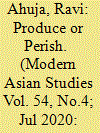

|
|
|
|
|
| Summary/Abstract |
This article argues that the late 1940s in India should no longer be reduced to the twin events of partition and independence. A generalized political crisis unsettled, for a brief period, the structures of social and economic power, and not just intercommunity relations and the constitution of the state. These years were thus, among other things, a catalytic moment for the definition of ‘labour’ as both a political category and a parameter of post-colonial politics: processes dating back to the First World War, at least, were consolidated, under pressure from this crisis, into a new labour regime that has withstood political pressure for almost seven decades. The article offers an analysis of the almost-forgotten post-war strike movement, which was nevertheless unprecedented in its social and geographical spread. The movement elicited both repressive and reformist responses: the extraordinary level of emergency powers applied to suppress it are, therefore, as much examined as the series of momentous legislative and institutional changes of the late 1940s. In conclusion, the long-term consequences of this cycle of strike–reform–repression for India's post-colonial labour regime are adumbrated. A strongly etatist, potentially authoritarian, regime of industrial relations, it is argued, was checked by an enduring political trade union pluralism. At the same time, divisions within India's working classes were deepened and consolidated as labour law and social legislation sealed off the comparatively small ‘core workforces’ of public sector and large-scale industrial enterprises from the majority of workers in what would soon be called the ‘informal economy’.
|
|
|
|
|
|
|
|
|
|
|
|
|
|
|
|
| 10 |
ID:
174428
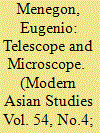

|
|
|
|
|
| Summary/Abstract |
One of the challenges of global history is to bridge the particularities of individual lives and trajectories with the macro-historical patterns that develop over space and time. Italian micro-history, particularly popular in the 1980s–1990s, has excavated the lives of small communities or individuals to test the findings of serial history and macro-historical approaches. Micro-history in the Anglophone world has instead focused more on narrative itself, and has shown, with some exceptions, less interest for ampler historiographical conclusions.
|
|
|
|
|
|
|
|
|
|
|
|
|
|
|
|
|
|
|
|
|